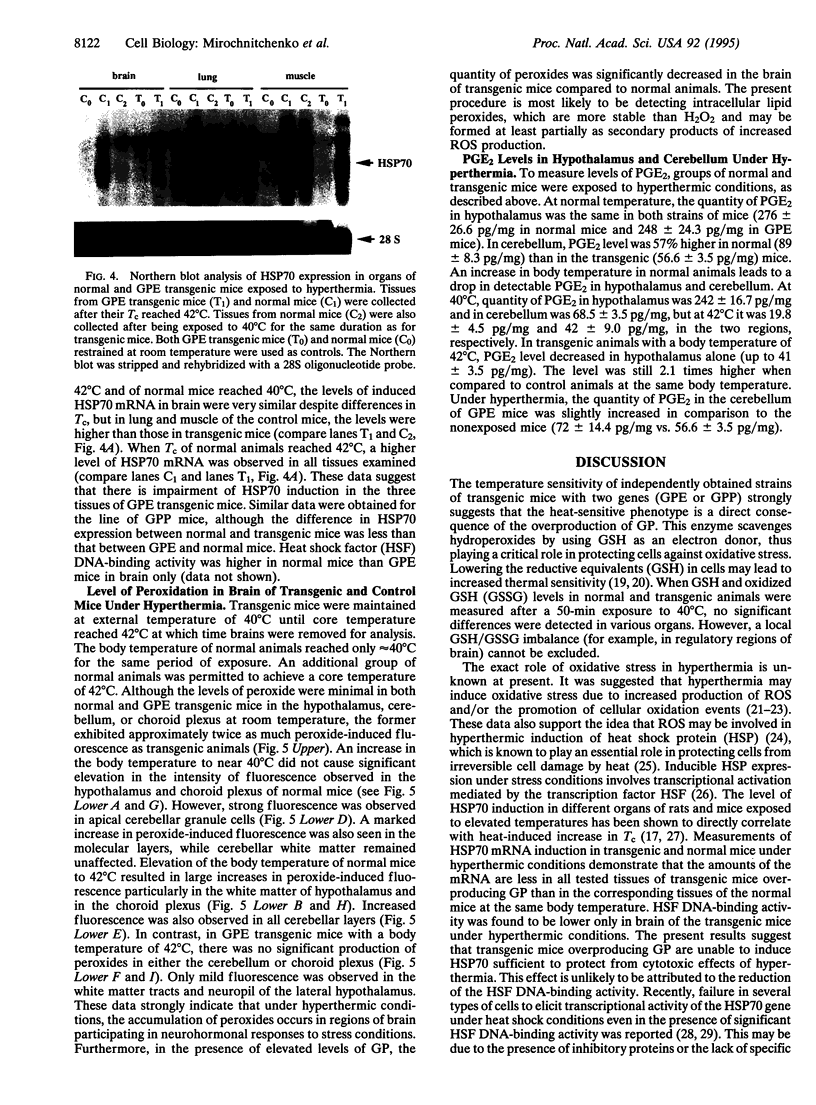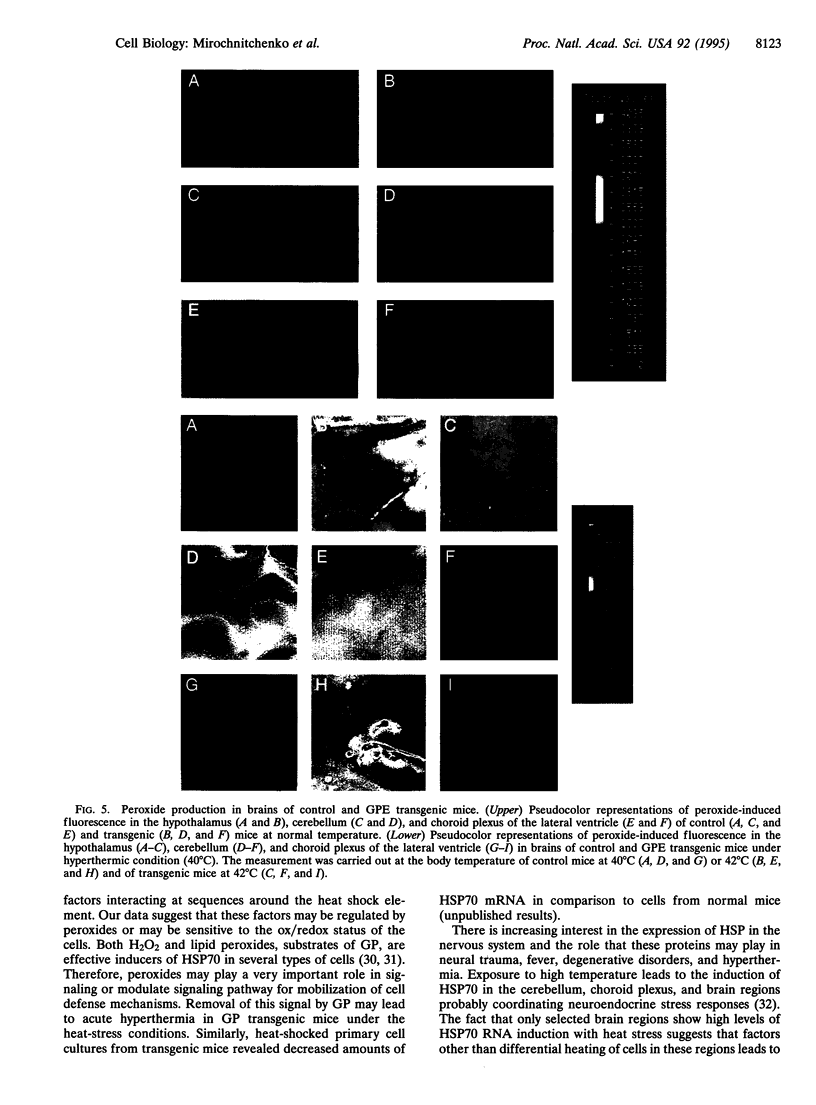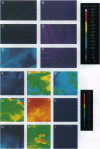Abstract
Exposure of humans and other mammals to hyperthermic conditions elicits many physiological responses to stress in various tissues leading to profound injuries, which eventually result in death. It has been suggested that hyperthermia may increase oxidative stress in tissues to form reactive oxygen species harmful to cellular functions. By using transgenic mice with human antioxidant genes, we demonstrate that the overproduction of glutathione peroxidase (GP, both extracellular and intracellular) leads to a thermosensitive phenotype, whereas the overproduction of Cu,Zn-superoxide dismutase has no effect on the thermosensitivity of transgenic mice. Induction of HSP70 in brain, lung, and muscle in GP transgenic mice at elevated temperature was significantly inhibited in comparison to normal animals. Measurement of peroxide production in regions normally displaying induction of HSP70 under hyperthermia revealed high levels of peroxides in normal mice and low levels in GP transgenic mice. There was also a significant difference between normal and intracellular GP transgenic mice in level of prostaglandin E2 in hypothalamus and cerebellum. These data suggest direct participation of peroxides in induction of cytoprotective proteins (HSP70) and cellular mechanisms regulating body temperature. GP transgenic mice provide a model for studying thermoregulation and processes involving actions of hydroxy and lipid peroxides in mammals.
Full text
PDF




Images in this article
Selected References
These references are in PubMed. This may not be the complete list of references from this article.
- Amstad P., Peskin A., Shah G., Mirault M. E., Moret R., Zbinden I., Cerutti P. The balance between Cu,Zn-superoxide dismutase and catalase affects the sensitivity of mouse epidermal cells to oxidative stress. Biochemistry. 1991 Sep 24;30(38):9305–9313. doi: 10.1021/bi00102a024. [DOI] [PubMed] [Google Scholar]
- Anderstam B., Harms-Ringdahl M. Relationship between cellular glutathione and hyperthermic toxicity in mammary carcinoma in mice. Int J Radiat Biol Relat Stud Phys Chem Med. 1986 Aug;50(2):231–240. doi: 10.1080/09553008614550621. [DOI] [PubMed] [Google Scholar]
- Anderstam B., Vaca C., Harms-Ringdahl M. Lipid peroxide levels in a murine adenocarcinoma exposed to hyperthermia: the role of glutathione depletion. Radiat Res. 1992 Dec;132(3):296–300. [PubMed] [Google Scholar]
- Becker J., Mezger V., Courgeon A. M., Best-Belpomme M. On the mechanism of action of H2O2 in the cellular stress. Free Radic Res Commun. 1991;12-13 Pt 1:455–460. doi: 10.3109/10715769109145817. [DOI] [PubMed] [Google Scholar]
- Blake M. J., Fargnoli J., Gershon D., Holbrook N. J. Concomitant decline in heat-induced hyperthermia and HSP70 mRNA expression in aged rats. Am J Physiol. 1991 Apr;260(4 Pt 2):R663–R667. doi: 10.1152/ajpregu.1991.260.4.R663. [DOI] [PubMed] [Google Scholar]
- Blake M. J., Gershon D., Fargnoli J., Holbrook N. J. Discordant expression of heat shock protein mRNAs in tissues of heat-stressed rats. J Biol Chem. 1990 Sep 5;265(25):15275–15279. [PubMed] [Google Scholar]
- Buckman T. D., Sutphin M. S., Mitrovic B. Oxidative stress in a clonal cell line of neuronal origin: effects of antioxidant enzyme modulation. J Neurochem. 1993 Jun;60(6):2046–2058. doi: 10.1111/j.1471-4159.1993.tb03489.x. [DOI] [PubMed] [Google Scholar]
- Cajone F., Bernelli-Zazzera A. Oxidative stress induces a subset of heat shock proteins in rat hepatocytes and MH1C1 cells. Chem Biol Interact. 1988;65(3):235–246. doi: 10.1016/0009-2797(88)90109-3. [DOI] [PubMed] [Google Scholar]
- Ceballos-Picot I., Nicole A., Briand P., Grimber G., Delacourte A., Defossez A., Javoy-Agid F., Lafon M., Blouin J. L., Sinet P. M. Neuronal-specific expression of human copper-zinc superoxide dismutase gene in transgenic mice: animal model of gene dosage effects in Down's syndrome. Brain Res. 1991 Jun 28;552(2):198–214. doi: 10.1016/0006-8993(91)90084-9. [DOI] [PubMed] [Google Scholar]
- Chomczynski P., Sacchi N. Single-step method of RNA isolation by acid guanidinium thiocyanate-phenol-chloroform extraction. Anal Biochem. 1987 Apr;162(1):156–159. doi: 10.1006/abio.1987.9999. [DOI] [PubMed] [Google Scholar]
- Craig E. A., Gross C. A. Is hsp70 the cellular thermometer? Trends Biochem Sci. 1991 Apr;16(4):135–140. doi: 10.1016/0968-0004(91)90055-z. [DOI] [PubMed] [Google Scholar]
- Epstein C. J., Avraham K. B., Lovett M., Smith S., Elroy-Stein O., Rotman G., Bry C., Groner Y. Transgenic mice with increased Cu/Zn-superoxide dismutase activity: animal model of dosage effects in Down syndrome. Proc Natl Acad Sci U S A. 1987 Nov;84(22):8044–8048. doi: 10.1073/pnas.84.22.8044. [DOI] [PMC free article] [PubMed] [Google Scholar]
- Gautier C., Mehtali M., Lathe R. A ubiquitous mammalian expression vector, pHMG, based on a housekeeping gene promoter. Nucleic Acids Res. 1989 Oct 25;17(20):8389–8389. doi: 10.1093/nar/17.20.8389. [DOI] [PMC free article] [PubMed] [Google Scholar]
- Gurney M. E., Pu H., Chiu A. Y., Dal Canto M. C., Polchow C. Y., Alexander D. D., Caliendo J., Hentati A., Kwon Y. W., Deng H. X. Motor neuron degeneration in mice that express a human Cu,Zn superoxide dismutase mutation. Science. 1994 Jun 17;264(5166):1772–1775. doi: 10.1126/science.8209258. [DOI] [PubMed] [Google Scholar]
- Harris E. D. Regulation of antioxidant enzymes. FASEB J. 1992 Jun;6(9):2675–2683. doi: 10.1096/fasebj.6.9.1612291. [DOI] [PubMed] [Google Scholar]
- Hightower L. E. Heat shock, stress proteins, chaperones, and proteotoxicity. Cell. 1991 Jul 26;66(2):191–197. doi: 10.1016/0092-8674(91)90611-2. [DOI] [PubMed] [Google Scholar]
- Marini A. M., Kozuka M., Lipsky R. H., Nowak T. S., Jr 70-kilodalton heat shock protein induction in cerebellar astrocytes and cerebellar granule cells in vitro: comparison with immunocytochemical localization after hyperthermia in vivo. J Neurochem. 1990 May;54(5):1509–1516. doi: 10.1111/j.1471-4159.1990.tb01198.x. [DOI] [PubMed] [Google Scholar]
- Mathur S. K., Sistonen L., Brown I. R., Murphy S. P., Sarge K. D., Morimoto R. I. Deficient induction of human hsp70 heat shock gene transcription in Y79 retinoblastoma cells despite activation of heat shock factor 1. Proc Natl Acad Sci U S A. 1994 Aug 30;91(18):8695–8699. doi: 10.1073/pnas.91.18.8695. [DOI] [PMC free article] [PubMed] [Google Scholar]
- Morimoto R. I. Cells in stress: transcriptional activation of heat shock genes. Science. 1993 Mar 5;259(5100):1409–1410. doi: 10.1126/science.8451637. [DOI] [PubMed] [Google Scholar]
- Murphy S. P., Gorzowski J. J., Sarge K. D., Phillips B. Characterization of constitutive HSF2 DNA-binding activity in mouse embryonal carcinoma cells. Mol Cell Biol. 1994 Aug;14(8):5309–5317. doi: 10.1128/mcb.14.8.5309. [DOI] [PMC free article] [PubMed] [Google Scholar]
- Oury T. D., Ho Y. S., Piantadosi C. A., Crapo J. D. Extracellular superoxide dismutase, nitric oxide, and central nervous system O2 toxicity. Proc Natl Acad Sci U S A. 1992 Oct 15;89(20):9715–9719. doi: 10.1073/pnas.89.20.9715. [DOI] [PMC free article] [PubMed] [Google Scholar]
- Rothwell N. J. CNS regulation of thermogenesis. Crit Rev Neurobiol. 1994;8(1-2):1–10. [PubMed] [Google Scholar]
- Schreck R., Albermann K., Baeuerle P. A. Nuclear factor kappa B: an oxidative stress-responsive transcription factor of eukaryotic cells (a review). Free Radic Res Commun. 1992;17(4):221–237. doi: 10.3109/10715769209079515. [DOI] [PubMed] [Google Scholar]
- Sherman L., Dafni N., Lieman-Hurwitz J., Groner Y. Nucleotide sequence and expression of human chromosome 21-encoded superoxide dismutase mRNA. Proc Natl Acad Sci U S A. 1983 Sep;80(18):5465–5469. doi: 10.1073/pnas.80.18.5465. [DOI] [PMC free article] [PubMed] [Google Scholar]
- Sies H. Strategies of antioxidant defense. Eur J Biochem. 1993 Jul 15;215(2):213–219. doi: 10.1111/j.1432-1033.1993.tb18025.x. [DOI] [PubMed] [Google Scholar]
- Simpson C. W., Ruwe W. D., Myers R. D. Prostaglandins and hypothalamic neurotransmitter receptors involved in hyperthermia: a critical evaluation. Neurosci Biobehav Rev. 1994 Spring;18(1):1–20. doi: 10.1016/0149-7634(94)90033-7. [DOI] [PubMed] [Google Scholar]
- Skibba J. L., Powers R. H., Stadnicka A., Cullinane D. W., Almagro U. A., Kalbfleisch J. H. Oxidative stress as a precursor to the irreversible hepatocellular injury caused by hyperthermia. Int J Hyperthermia. 1991 Sep-Oct;7(5):749–761. doi: 10.3109/02656739109056444. [DOI] [PubMed] [Google Scholar]
- Sukenaga Y., Ishida K., Takeda T., Takagi K. cDNA sequence coding for human glutathione peroxidase. Nucleic Acids Res. 1987 Sep 11;15(17):7178–7178. doi: 10.1093/nar/15.17.7178. [DOI] [PMC free article] [PubMed] [Google Scholar]
- Takahashi K., Akasaka M., Yamamoto Y., Kobayashi C., Mizoguchi J., Koyama J. Primary structure of human plasma glutathione peroxidase deduced from cDNA sequences. J Biochem. 1990 Aug;108(2):145–148. doi: 10.1093/oxfordjournals.jbchem.a123172. [DOI] [PubMed] [Google Scholar]
- Tsuchiya M., Suematsu M., Suzuki H. In vivo visualization of oxygen radical-dependent photoemission. Methods Enzymol. 1994;233:128–140. doi: 10.1016/s0076-6879(94)33015-8. [DOI] [PubMed] [Google Scholar]
- Yarom R., Sapoznikov D., Havivi Y., Avraham K. B., Schickler M., Groner Y. Premature aging changes in neuromuscular junctions of transgenic mice with an extra human CuZnSOD gene: a model for tongue pathology in Down's syndrome. J Neurol Sci. 1988 Dec;88(1-3):41–53. doi: 10.1016/0022-510x(88)90204-3. [DOI] [PubMed] [Google Scholar]





